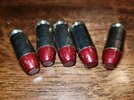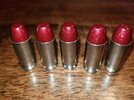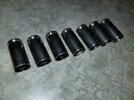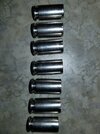Shivahasagun
Member
- Joined
- Jul 12, 2021
- Messages
- 915
I'm not firing those bullets with the messed up coating. They are just test dummies.I am not a perfectionist, but those loads do not looks good. Coating is missing and it looks like the bullet ogive is inside the case neck.
This is what I do to verify the ogive is outside the case neck. I use another resized case and put it neck down on the bullet side of the round. If the two cases touch and you you can turn the case without any issues, then I back out the bullet a bit. If the case cannot turn, then you have a good COL with the ogive outside the neck. Just remember to test a round with your longest case. This is a 357sig example of an ogive outside the neck.
View attachment 1205119
Speaking of a dummy, I do not understand your bullet-ogive-inside-the-case test / procedure.
I loaded 130 rds tonight. I need to shoot some before loading any more.
I have to inspect these nickle cases more carefully than I normally do. Some have tiny, or little cracks at the mouth. I don't mind if they are tiny, and stay tiny after loading. Tension is good. But I noticed the ones with larger, but still little, cracks are the ones that sometimes split while seating the bullet. So I'm discarding those as I go now. (Instead of loading them and hoping they don't split)





